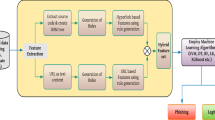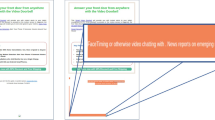Abstract
Reviews of product or stores exist extensively in online e-commerce platform which is important for customers to make decisions. For economic reasons some dishonest people are employed to write fake reviews which is also called “opinion spamming” to promote or demote target products and services. Previous researches have made use of text similarity, linguistics, rating patterns, graph relationship and other behaviors for spammer detection. They mainly utilized product review list while it is difficult to find fake reviews by glancing over product reviews in time-descending order. Meanwhile there exists lots of useful information in the list of reviews of reviewers and relationships between reviewers when reviewers commonly reviewed the same stores. We propose the concept of review group and to the best of our knowledge, it’s the first time the review group concept is proposed and used. Review grouping algorithm is designed to effectively split reviews of reviewer into groups which participate in building novel grouping models to identify both positive and negative deceptive reviews. Several new features which are language independent based on group model are constructed. Additionally, we explore the collusion relationship between reviewers to build reviewer group collusion model. Evaluations show that the review group method and reviewer group collusion models can effectively improve the precision by 4%–7% compared to the baselines in fake reviews classification task especially when reviews are posted by professional review spammers.








Similar content being viewed by others
References
Qin M, Ke Y (2014) Overview of web spammer detection. J Softw 25:1505–1526
Mukherjee A, Liu B, Glance N (2012) Spotting fake reviewer groups in consumer reviews. In: proceedings of the 21st international conference on world wide web, pp. 191-200
Jindal N, Liu B (2008) Opinion spam and analysis. In: proceedings of the 2008 international conference on web search and data mining, pp. 219-230
Mukherjee A, Kumar A, Liu B, Wang J, Hsu M, Castellanos M, Ghosh R (2013) Spotting opinion spammers using behavioral footprints. In: proceedings of the 19th ACM SIGKDD international conference on knowledge discovery and data mining, pp. 632-640
Feng S, Banerjee R, Choi Y (2011) Syntactic stylometry for deception detection. In: Proceedings of the 50th Annual Meeting of the Association for Computational Linguistics: Short Papers Vol 2, pp. 171–175
Rout JK, Dalmia A, Choo KKR et al. (2017) Revisiting semi-supervised learning for online deceptive review detection. IEEE access: 1319-1327, https://doi.org/10.1109/ACCESS.2017.2655032
Ott M, Choi Y, Cardie C, Hancock JT (2011) Finding deceptive opinion spam by any stretch of the imagination. In: Proceedings of the 49th Annual Meeting of the Association for Computational Linguistics: Human Language Technologies Vol 1, pp. 309–319
Crawford M, Khoshgoftaar TM, Prusa JD, Prusa JD, Richter AN, al Najada H (2015) Survey of review spam detection using machine learning techniques. Journal of Big Data 2(1):23. https://doi.org/10.1186/s40537-015-0029-9
Lau RYK, Liao SY, Kwok CW, Xu K, Xia Y, Li Y (2011) Text mining and probabilistic language modeling for online review spam detection. ACM Trans Manag Inf Syst 2(4):1–30
Mukherjee A, Liu B, Wang J, Glance N, Jindal N (2011) Detecting group review spam. In: proceedings of the 20th international conference companion on world wide web, pp. 93-94
Fei, G., Mukherjee, A., Liu, B., Hsu, M., Castellanos, M., Ghosh, R. (2013) Exploiting burstiness in reviews for review spammer detection. In proceedings of ICWSM-13, pp. 175-184
Li H, Fei G, Wang S, Liu B, Shao W, Mukherjee A Shao J (2017) Bimodal distribution and co-bursting in review spam detection. In: WWW2017, pp.1063-1072. https://doi.org/10.1145/3038912.3052582
Stringhini G, Kruegel C, Vigna G (2010) Detecting spammers on social networks. In: proceedings of the 26th annual computer security applications conference, pp. 1-9
Zheng X, Zeng Z, Chen Z, Yu Y, Rong C (2015) Detecting spammers on social networks. Neurocomputing. 159:27–34
Amleshwaram AA, Reddy N, Yadav S, Gu G, Yang C (2013) Cats: characterizing automation of twitter spammers. In: fifth international conference on communication systems and networks (COMSNETS), pp. 1-10
Lin C, He J, Zhou Y, Yang X, Chen K, Song L (2013) Analysis and identification of spamming behaviors in sina weibo microblog. In: proceedings of the 7th workshop on social network mining and analysis, pp. 5
Niu X, Liu G, Yang Q (2018) Trustworthy website detection based on social hyperlink network analysis. IEEE transactions on network science and engineering, pp. 1–12
Li X, Yang Q, Lin X, Wu S, Wittie M (2016) itrust: Interpersonal trust measurements from social interactions, IEEE Network, vol. 30, no. 4, pp. 54–58
Liu G, Chen Q, Yang Q, Zhu B, Wang H, Wang W (2017) Opinionwalk: an efficient solution to massive trust assessment in online social networks. INFOCOM 2017, IEEE, pp.1–9
Liu G, Yang Q, Wang H, Wu S, Wittie MP (2015) Uncovering the mystery of trust in an online social network. In IEEE CNS. IEEE, pp. 488–496
Li J, Ott M, Cardie C, Hovy E (2014) Towards a general rule for identifying deceptive opinion spam. In: proceedings of the 52nd annual meeting of the Association for Computational Linguistics
Ott M, Cardie C, Hancock J (2013) Negative deceptive opinion spam. In: Proceedings of NAACL-HLT, pp. 497–501
Li F, Huang M, Yang Y et al. (2011) Learning to identify review spam, International Joint Conference on Artificial Intelligence
Li Y, Feng X, Zhang S (2016) Detecting fake reviews utilizing semantic and emotion model. In: 2016 3rd international conference on information science and control engineering (ICISCE), pp. 317-320
Rout JK, Singh S, Jena SK et al (2017) Deceptive review detection using labeled and unlabeled data. Multimedia Tools & Applications 76(3):1–25
Peng Q, Zhong M (2014) Detecting spam review through sentiment analysis. J Softw Vol 9(8):2065–2072
Choo E, Yu T, Min C (2015) Detecting opinion spammer groups through community discovery and sentiment analysis. In: IFIP International Federation for Information Processing 2015. LNCS 9149:170–187
Shojaee S, Murad MAA, Bin Azman A, Sharef NM, Nadali S (2013) Detecting deceptive reviews using lexical and syntactic features. In: proceedings of 13th international conference on intelligent systems design and applications, pp 53–58
Wang G, Xie S, Liu B, Philip SY (2011) Review graph based online store review spammer detection. In: IEEE 11th international conference on data mining, pp. 1242-1247
Wang Z, Gu S, Zhao X et al (2018) Graph-based review spammer group detection. Knowledge & Information Systems. Vol. 55(3):571–597
Agrawal R, Srikant R (1994) Fast algorithms for mining association rules. In: Proc. 20th int. conf. Very large data bases, VLDB, pp. 487-499
Han J, Pei J, Yin Y, Mao R (2004) Mining frequent patterns without candidate generation: a frequent-pattern tree approach. Data Min Knowl Disc 8:53–87
Mukherjee A, Venkataraman V, Liu B, Glance NS (2013) What yelp fake review filter might be doing?. In: Proceedings of the Seventh International AAAI Conference on Weblogs and Social Media
Wang F, Qi S, Gao G, Zhao S, Wang X (2016) Logo information recognition in large-scale social media data. Multimed Syst. 22(1):63–73
Witten IH, Frank E, Hall MA, Pal CJ (2016) Data mining: practical machine learning tools and techniques
Acknowledgments
This work has been supported by the National Key R&D Program of China under Grant NO.2017YFB1401000 and the Key Laboratory of Digital Rights Services, which is one of the National Science and Standardization Key Labs for Press and Publication Industry, National Natural Science Foundation of China (NO.61672328).
Author information
Authors and Affiliations
Corresponding author
Additional information
Publisher’s note
Springer Nature remains neutral with regard to jurisdictional claims in published maps and institutional affiliations.
Rights and permissions
About this article
Cite this article
Li, Y., Wang, F., Zhang, S. et al. Detection of Fake Reviews Using Group Model. Mobile Netw Appl 26, 91–103 (2021). https://doi.org/10.1007/s11036-020-01688-z
Accepted:
Published:
Issue Date:
DOI: https://doi.org/10.1007/s11036-020-01688-z




